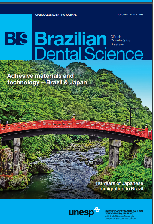Hygroscopic expansion of bulk fill composites: A three-month report
DOI:
https://doi.org/10.14295/bds.2018.v21i2.1521Abstract
Polymer networks are considered to be largely affected by water and chemical absorption from environment. Objective: The aim of this study was to evaluate the hygroscopic expansion of bulk-fill composite. Material and Methods: Fifteen disks (5 in each group) with different thickness(4mm/2mm) of Tetric N-Ceram Bulk Fill composite(TB) and Tetric N-Ceram composite(TN) were made according to the manufacturer’s instruction and stored in deionized water. The length of each specimen was recorded using a digital micrometer at baseline and at the end of 24 h, 1, 2, 4, 12 weeks intervals. Repeated measure ANOVA and Tukey HSD were used to determine the effect of variables. At 12 weeks, the mean hygroscopic expansion after water immersion ranged between 0. 33±0.09mm for TN to 0.41±0.07mm for TB with 2mm thickness. Repeated measure ANOVA revealed a significant increase in hygroscopic expansion over time (P<0.05). Results: The results indicated that at 24hours and 2weeks there was a significant difference among TN and TBwith 4mm thickness (p=0.007 and p=0.023, respectively). The other differences were not significant. Hygroscopic expansion affected by the type of composite and the passing of time. Conclusion: The results showed that the time taken to reach stabilization in hygroscopic expansion was shorter for TN in comparison with TB. For 2mm thickness equilibrium was attained earlier.
Keywords
Water; Expansion; Composites; Polymerization; Bulk-fill.
Downloads
Downloads
Additional Files
Published
How to Cite
Issue
Section
License
Brazilian Dental Science uses the Creative Commons (CC-BY 4.0) license, thus preserving the integrity of articles in an open access environment. The journal allows the author to retain publishing rights without restrictions.
=================




























